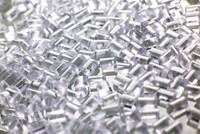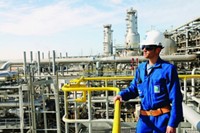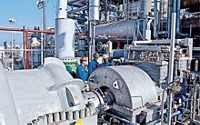Advertisement
Grab your lab coat. Let's get started
Welcome!
Welcome!
Create an account below to get 6 C&EN articles per month, receive newsletters and more - all free.
It seems this is your first time logging in online. Please enter the following information to continue.
As an ACS member you automatically get access to this site. All we need is few more details to create your reading experience.
Not you? Sign in with a different account.
Not you? Sign in with a different account.
ERROR 1
ERROR 1
ERROR 2
ERROR 2
ERROR 2
ERROR 2
ERROR 2
Password and Confirm password must match.
If you have an ACS member number, please enter it here so we can link this account to your membership. (optional)
ERROR 2
ACS values your privacy. By submitting your information, you are gaining access to C&EN and subscribing to our weekly newsletter. We use the information you provide to make your reading experience better, and we will never sell your data to third party members.
Business
Spotlight on Polymers
Flat demand and high energy prices mark a setback versus a year ago, but producers believe a comeback looms
by Alexander H. Tullo
September 12, 2005
| A version of this story appeared in
Volume 83, Issue 37
A year ago, profits for commodity polymer makers were soaring as markets tightened and prices rose high above production costs. But 2005 has brought the industry back down to earth. Demand in North America hasn't improved over last year. And with little leverage to raise prices, producers have been at the mercy of ever-increasing costs for both energy and raw materials.
As if the year wasn't unpredictable enough, Hurricane Katrina, which caused unprecedented damage to the civil order and socked the petrochemical industry on the U.S. Gulf Coast, will have effects on polymer markets that can't, at the moment, be predicted.

These wrenching uncertainties are occurring against a backdrop of longer term changes in polymer markets. The industry isn't going through the consolidation it did at the turn of the millennium, when companies such as Equistar, Chevron Phillips, ExxonMobil, and Basell were formed, and Dow acquired Union Carbide. But businesses like Basell and Borealis are changing hands, and Innovene has been carved out of BP in preparation to go public as an independent company.
Whether old or new, polymer makers must face up to markets that, in the U.S. and Canada at least, aren't shaping up to be as strong as they were last year. According to the American Plastics Council, out of polypropylene, polystyrene, and various grades of polyethylene, only linear low-density polyethylene (LLDPE) is posting an increase in demand through June--and it's merely a 0.5% increase.
Last year, in contrast, saw a huge rebound from the previous three years of ebbing or mediocre demand. Polyethylene demand grew by 8.9% while polypropylene grew by 5.9% and polystyrene posted a 4.4% gain.
And energy and feedstock prices, already high in 2004, have risen to stratospheric levels this year. Prices for West Texas Intermediate crude oil have risen steadily from $42 a barrel in January to $69 at the end of August, just after Hurricane Katrina hit. During the same period, spot prices for natural gas traded on the New York Mercantile Exchange rose from $6.00 to $11.50 per million Btu.
Patrick W. Duke, a plastics analyst with Houston-based DeWitt & Co., says feedstock costs are now pushing up polymer prices, even though supply-and-demand dynamics pre-Katrina didn't justify the price hikes. In turn, he says, the rising prices will spur buying on the part of converters who want to stock up on resins before prices increase even more.
Duke says his benchmark polyethylene price of 70 cents per lb in January lost about 14 cents during the first quarter of this year. Later, producers implemented a 6-cent price increase and nominated another 13 cents' worth of increases through September that are yet to take hold.
In polypropylene, Duke's 69-cent benchmark price lost about 8 to 9 cents in the first quarter. Producers won a 4-cent increase in August and are trying to push through another 10 cents.
"These price increases are being driven by feedstock costs," Duke says. He says the volatile environment has created "panic buying" among converters that will likely provide momentum to polymer sales volumes for the rest of the year.
Tim Taylor, senior vice president for olefins and polyolefins at Chevron Phillips Chemical, expects polyethylene volumes to improve during the year. "Various reports suggest that supplies will remain adequate but are expected to tighten globally in the second half of this year and continue to be relatively tight over the next several years," he says.
In polypropylene, Basell says a recovery in demand and subsequent tightening of the market in the second half of the year will improve already-strong results. "The global polypropylene utilization rate was at the high 80% level in the first half of the year--and much higher in certain regions like North America--despite the destocking in the supply chain which took place earlier in the year," a Basell spokeswoman says.
Polystyrene markets still have a ways to go before they become profitable, says Christopher D. Pappas, president of styrenics for Nova Chemicals. He explains that because there is less capacity for styrene than there is for derivatives such as polystyrene, it is the balance of supply and demand for styrene, not polystyrene, that determines profitability in the styrenics chain.
Unlike the polyolefins industry, Pappas says, styrene is still waiting for a cyclical profit run-up because it has yet to work off the excess capacity built between 1999 and 2002. "The fact is that the styrenics chain has been a laggard in cyclical rebound relative to the ethylene chain or the chlor-alkali chain," he says.
Pappas, however, says he expects styrene markets to tighten this year, with exports to Asia--which consumes about 42% of the world's styrene--sweetening an improving domestic market for North American producers. Plants serving Asia, he notes, are running at nearly full capacity. "Directionally," he says, "2006 appears to be a turning-point year for the styrenics chain, and we hope to enjoy that cyclical rebound."
THESE WERE the assessments before Hurricane Katrina hit the U.S. Gulf Coast. As of Sept 1., according to the petrochemical consultancy Chemical Market Associates Inc. (CMAI), five large ethylene crackers, together representing some 9% of North American ethylene capacity, were shut down in Louisiana because of the hurricane. Another 6.5% of capacity was operating at reduced rates. In addition, nine oil refineries were shut down, and operations at another two were slowed by Katrina.
Downstream, the hurricane sidelined Dow Chemical's 1.6 billion-lb-per-year polyethylene unit in Taft, La., which alone represents about 3.7% of North American polyethylene capacity, CMAI says. Dow also suffered the temporary loss of its Norco, La., polypropylene unit, and Pinnacle Polymers had to idle its Garyville, La., polypropylene plant; together, the units represent almost 7% of U.S. capacity.
Nearly 30% of North American styrene capacity is in two large units--a Chevron Phillips plant and the Cosmar joint venture between Total Petrochemicals and General Electric--that were shut down because of the storm, CMAI says.
DeWitt's Duke says the outages, plus railroad logistics strained by damaged infrastructure, will exacerbate the polymer buying frenzy during the second half of the year. "It looked like producers were on a path to break even in terms of demand or show a little growth in polymers," he says. "People will now try to get their hands on whatever product they can get their hands on. That won't necessarily mean more volumes; we may lose a month of production here."
Before the hurricane, Duke had already been concerned about the effects of rising feedstock costs on the economy. He argued that a slowdown in the economy may push the next downturn in polymers from about 2007 to about 2006. Hurricane Katrina "has changed the outlook entirely," he says. "It is no longer an issue of the polymer industry trying to sustain profitability, but the ability of the economy to sustain itself with all these additional costs hitting the system."
The effects of the hurricane and escalating hydrocarbon prices notwithstanding, the next downturn in the polymer industry is likely to be determined by the balance between supplies in the Middle East and demand in Asia. In May, ExxonMobil Chemical President Michael J. (Mike) Dolan told investors that "China alone is positioned to capture a third of demand growth for commodities between now and 2015."
With China becoming increasingly important, the polymer industry runs the risk that sluggish demand in China will cause Middle Eastern-made products to find a home elsewhere, namely in Europe. "China demand and expected capacity growth, combined with potential delays in Middle Eastern expansion projects, will determine the exact timing of the next trough," the Basell spokeswoman says.
Chevron Phillips says the future petrochemical business cycle will be driven by global supply-and-demand balances, and it is responding with a strategy of building new capacity where feedstock prices are lowest.
The company is in the midst of constructing its second joint-venture project with Qatar Petroleum. It is also considering an ethylene joint venture with Saudi Industrial Investment Group that will have downstream styrene, 1-hexene, polypropylene, and polystyrene plants. The plant awaits approval from Chevron Phillips' board and the preparation of a formal development plan. "The products manufactured at such a facility would be available to serve markets in Europe and Asia," Chevron Phillips CEO Jim Gallogly says.
Indeed, most companies have a strategy for the Middle East. Companies such as ExxonMobil, Total Petrochemicals, Saudi Basic Industries Corp., and Dow Chemical are pursuing integrated ethylene/polyolefins projects in the region. In addition, three companies that are in a state of ownership flux--Basell, Borealis, and Innovene--have large investments planned for the region.
In August, Access Industries, a private investment firm led by Len Blavatnik, purchased Basell for $5.4 billion from owners BASF and Shell Chemicals. Basell says Access believes in continuity for its new company and that "there is a strong consensus on vision and strategy" between the new owners and employees.
This would suggest a continuation of the gradual transformation Basell has undergone since its formation in 2000. The company has been able to reduce annual costs, for instance, by about $360 million.
It has also been focusing on back-integration into raw materials. "For its European polyethylene business, Basell wants to achieve more than 85% back-integration into feedstocks," the spokeswoman says. To this end, the company is planning to expand ethylene capacity in Wesseling, Germany, by about 280,000 metric tons per year and seeks to buy out Shell Chemicals' share in the cracker joint venture in Aubette, France.
BASELL IS also strengthening its hand in the Middle East. In 2004, the company started up the Saudi Polyolefins Co. joint venture in Saudi Arabia, which consists of a polypropylene plant and companion propane dehydrogenation facility. It is also developing an 800,000-metric-ton ethylene/polyethylene joint venture in Saudi Arabia. And it is expected to complete another polypropylene/propane dehydrogenation joint venture in Saudi Arabia in 2007.
Basell has also been realigning its asset portfolio around the world. In South America, the company is selling its stake in the Polibrasil polypropylene joint venture to its partner, local industrial conglomerate Suzano Petroquìmica. At the same time, it is buying out Suzano's share of a Brazilian polypropylene compounding business and Repsol YPF's share of an Argentine polypropylene joint venture.
Basell is selling its stake in a Tarragona, Spain, joint venture to its partner Repsol. "Basell's goal is to focus on wholly owned production facilities in Tarragona," the company says. Basell has also bought and is expanding the Qenos polypropylene business in Australia and has sold its stake in the Belgian CIPEN polyethylene joint venture with ExxonMobil.

A recent report by CMAI concludes that Basell has indeed improved its business. "The short-term outlook for Basell is considerably brighter than in the past," the consulting firm writes. "Streamlined through extensive restructuring and efficient in its business and technology focus, Basell is well-positioned in the very cyclical business of commodity chemicals."
Basell isn't the only major polymers producer to be sold recently. Statoil's 50% stake in European polyolefins firm Borealis is being purchased by its two minority shareholders, Austrian refiner OMV, which is one of Borealis' major feedstock suppliers in Europe, and the Abu Dhabi-based firm International Petroleum Investment Co.
When the sale was announced in late June, IPIC Managing Director Mohamed Al Khaily noted that the transaction would likely expand Borealis' involvement in the Middle East through its Borouge ethylene/polyethylene joint venture with Abu Dhabi National Oil Co. (ADNOC) in the United Arab Emirates. "IPIC's increased ownership in Borealis will further deepen the ties between Borealis and Borouge, providing an even stronger foundation for continued growth in the Middle East," Al Khaily said.
The other shoe dropped less than a week later when Borealis and ADNOC announced plans for a $2.5 billion polymer project in Abu Dhabi that will include ethylene, polyethylene, and polypropylene plants. They expect to complete the project in 2010.
BP's Innovene unit is expected to launch an initial public offering by the end of the year. BP recently revealed that its stake in the just-completed Secco petrochemical joint venture in China won't become part of Innovene. However, an Innovene spokesman says the company is making headway in China through a specialized marketing and sales organization. "Over the recent months, this approach has proven to be very successful, and we have seen a dramatic increase in the volume of the Innovene product moving into China," he says.
Advertisement
MOREOVER, the company is planning a $2 billion ethylene and derivatives complex in Saudi Arabia with the local firm Delta Oil.
The Innovene spokesman adds that even though the company is separating from its oil company parent, it is actually enhancing integration with raw materials. The new firm will include refineries in Grangemouth, Scotland, and Lavéra, France, that are intimately connected to associated petrochemical complexes. Because the sites have been managed by multiple BP divisions, being under one roof as Innovene will serve to improve integration, he maintains.
Innovene is also embarking on the only merger in the Western commodity plastics industry this year through its formation of a European polystyrene business with Nova. The venture, the largest polystyrene maker in Europe, is set to start operations by the end of this month.
Nova's Pappas says the merger will likely reduce costs by $40 million to $45 million annually in the combined business. This savings will come in part from the closure of capacity. While Pappas doesn't know which of the new joint venture's plants will be slated for shutdown, he does acknowledge that Nova's Carrington, England, expandable polystyrene plant was mothballed in 2002 and is still off-line.
The strategy of the venture is much like those of other ventures operating in industries where business conditions eventually improved. "We think that the new company will be entering the business at a time when the market is seeing some strength in supply-and-demand dynamics," Pappas says.








Join the conversation
Contact the reporter
Submit a Letter to the Editor for publication
Engage with us on Twitter